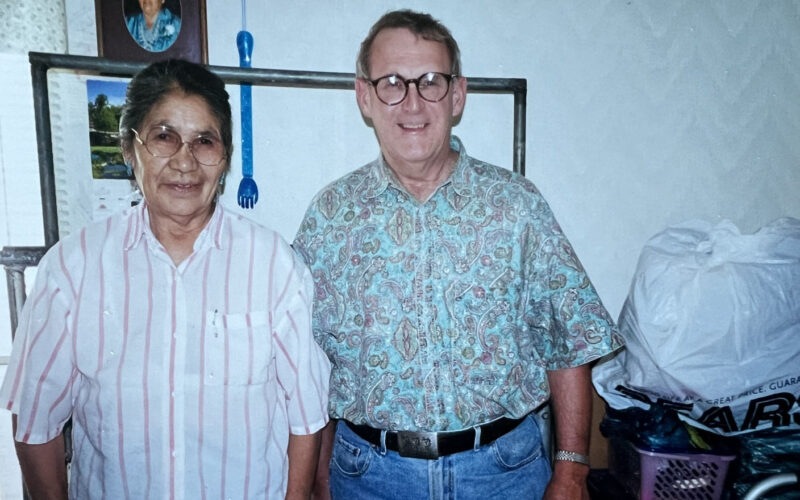Dustin Staggs
NWA Democrat-Gazette
When you open the large wooden doors of the Museum of Native American History (MONAH) in Bentonville, you receive an almost startling greeting from a recorded mammoth roar (even if an A-frame sign warns you) and “Tusker,” the large skeleton remains of a woolly mammoth from the Paleo Period.
Amongst the more than 10,000 Native American artifacts the museum houses, and towards the very back room, are eight beautifully woven Navajo rugs that tell the story of a healing tradition passed on through generations.
These intricate rugs were graciously donated in 2022 by Howard Cockrill, a retired radiologist from Little Rock, and make up “The Way of Beauty: Diné Woven Tapestry Stories” exhibit. The rugs showcase Navajo artwork spanning over a century, with works ranging from the late 1800s to the early 2000s. The eight rugs are rotated every six months, and the museum will pull new ones from Dr. Cockrill’s collection on June 15 of this year.
“[These] rugs are all about highlighting the amazing Navajo weavers throughout history,” said Director Jazlyn Sanderson. “These particular ones [on display] are highlighting even more details about deities and creation ceremonies and even extinct ceremonies that we haven’t been able to highlight in detail before.”
Dr. Cockrill’s interest in Navajo rugs began unexpectedly on a trip to Utah, when he came across a sand painting rug at a trading post on a Navajo reservation. “It captured my fancy,” he said over the phone, recounting how a fortuitous purchase launched decades of collecting. As a healer himself in his own way and practice, he was particularly intrigued at the spiritual depth of these sand paintings used in ceremonial Navajo healing practices.
Sand paintings, Cockrill explains, are created by medicine men during healing ceremonies to depict sacred deities and mythical stories that are part of the Navajo culture passed from generation to generation orally. There is no Bible or book for reference, as the knowledge of the ceremonies, including the chants and movements, is stored in the medicine man’s memory. An average ceremony lasts somewhere between five and nine days, said Cockrill. It’s filled with numerous rituals and ways of preparation to dispel any ill humors that the patient might have.
To create these sacred sand paintings, Cockrill said the medicine man of the tribe “paints” by letting colored sand fall carefully through his fingers and onto the ground, creating symbols and holy figures. A very simple sand painting might take two or three hours, but more complex ones might take almost a full day with several helpers. It has to be precisely done so the gods depicted in the painting can be drawn into the design and their powers can be used to heal. This all takes place in a special building called a hogan, which might be comparable to a chapel.
After the sand painting is completed, a person who is suffering an illness or issue is asked to sit on the painting while the medicine man recites healing chants. The paintings serve as spiritual conduits, delivering the gods’ blessings to the patient before having to be ceremonially destroyed. The sand painting is considered toxic and destroyed because it has absorbed the illness of the patient. They are also seen as sacred and should only exist temporarily because they hold so much power.
However, according to the museum, a famous healer and weaver Hosteen Klah and other modern Navajo members started creating these sand painting designs on wool tapestries. Cockrill said Klah was worried that the rituals and ceremonies were dying out as the Navajo tribe got more involved with modernists and worried the rituals would die out with the medicine men, so he wove these textile rugs. It was believed that these textiles the Navajo created would hold that same power the sand paintings provided and would be used in ceremonies to pray and heal members of the tribe.
Over the span of 45 years, Cockrill’s collection grew to include more than 70 Navajo textile rugs, including rare sand painting works by master weavers such as Hosteen Klah himself and Anita Tsosie.
“I am convinced that the world is divided into two categories, collectors and non-collectors,” Cockrill said. “If you are afflicted with the collecting bug — which I am — it was a natural tendency to start acquiring them.”
The exhibition “The Way of Beauty” is a continuation of the museum’s commitment to recognizing Indigenous cultures. MONAH was founded by David Bogle, a registered member of the Cherokee Nation and Bentonville native. Bogle was a collector of Native American artifacts himself before founding the museum. The collection of these historic artifacts outgrew his own home and the museum’s downtown location in Bentonville, before eventually finding its permanent home in 2008.
Dr. Cockrill said he got to know Bogle through another fellow doctor, a friend who collects Quapaw pottery. Cockrill could have easily called in an auctioneer and auctioned off his collection, separating them, but he said, “Those are sort of my children. I kind of wanted to keep them together.”
Cockrill said he hoped by donating the collection to the museum he would contribute the same sense of interest that was instilled in him when he first saw that rug on his trip to Utah and help discover not just the delicate workmanship of Navajo weavers but also the rich spiritual traditions and tales they carry forth.
—
FAQ
“The Way of Beauty”
WHAT — Diné woven tapestry stories from the life-long collection of Dr. Howard Cockrill
WHEN — 11 a.m.-5 p.m. Tuesday-Saturday. Current set of rugs up until June 14.
WHERE — Museum of Native American History, 202 S.W. O St., Bentonville
COST — Free admission.
INFO — monah.org



